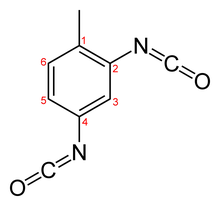This is an old revision of this page, as edited by Beetstra (talk | contribs) at 16:07, 9 January 2012 (Saving copy of the {{chembox}} taken from revid 468760294 of page Toluene_diisocyanate for the Chem/Drugbox validation project (updated: '').). The present address (URL) is a permanent link to this revision, which may differ significantly from the current revision.
Revision as of 16:07, 9 January 2012 by Beetstra (talk | contribs) (Saving copy of the {{chembox}} taken from revid 468760294 of page Toluene_diisocyanate for the Chem/Drugbox validation project (updated: '').)(diff) ← Previous revision | Latest revision (diff) | Newer revision → (diff)| This page contains a copy of the infobox ({{chembox}}) taken from revid 468760294 of page Toluene_diisocyanate with values updated to verified values. |

| |

| |
| Names | |
|---|---|
| IUPAC name 2,4-diisocyanato-1-methyl-benzene | |
| Other names
Tolylene diisocyanate Methyl phenylene diisocyanate | |
| Identifiers | |
| CAS Number | |
| 3D model (JSmol) | |
| ChEBI | |
| ChEMBL | |
| ChemSpider | |
| RTECS number |
|
InChI
| |
SMILES
| |
| Properties | |
| Chemical formula | C9H6N2O2 |
| Molar mass | 174.2 g/mol |
| Appearance | Colorless to pale yellow, liquid |
| Density | 1.214 g/cm, liquid |
| Melting point | 21.8 °C (295.0 K) |
| Boiling point | 251 °C (524 K) |
| Solubility in water | Reacts |
| Hazards | |
| NFPA 704 (fire diamond) |
 |
| Flash point | 127 °C |
| Related compounds | |
| Except where otherwise noted, data are given for materials in their standard state (at 25 °C , 100 kPa).
| |